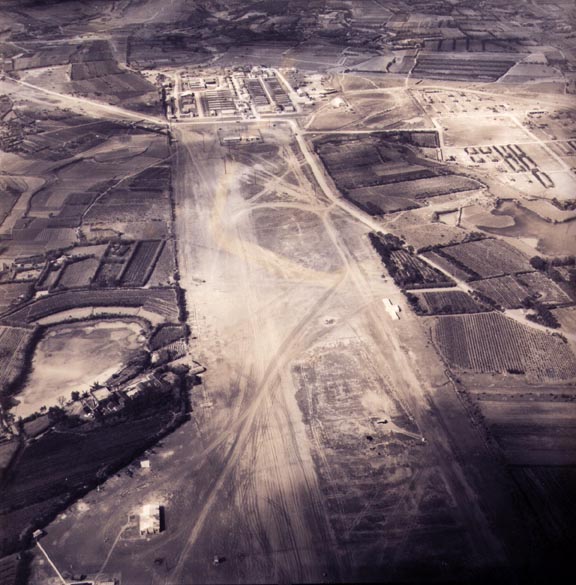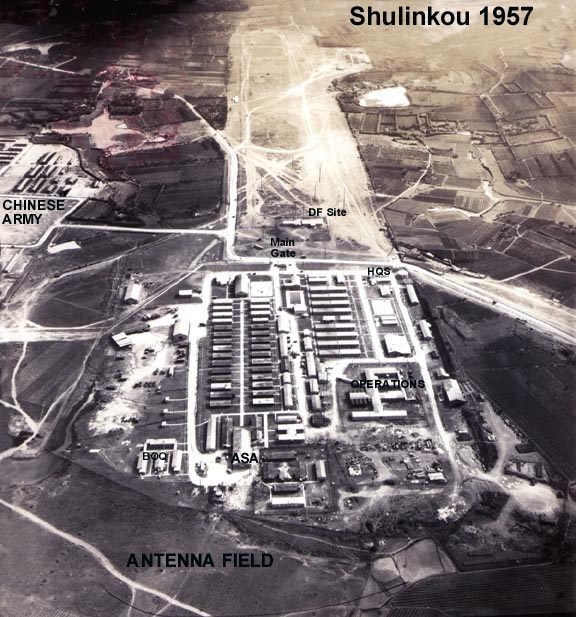Recollections reveal that a hearability test was conducted in 1955 and 1956 by a team
headed by USAFSS officers Delmar Lang and Ben Ardisana. The team went to Taiwan
from the 6925th Radio Group Mobile (RGM) at Clark Air Base in the Philippines, and
satellited with a small Army Security Agency (ASA) direction-finding detachment which
was located on an old Japanese fighter strip just a few miles from the village of Shulinkou. See aerial photos of the site below (click on each to enlarge view).
[NOTE: Variations are found for the spelling of Shu Lin Kou, such as Shu Lin
Kou, Shulinkou, Shu Lin (on British Admiralty maps), etc. For this article the more
common spelling Shulinkou shall be used throughout.]
Subsequent to apparent successful tests the team formed a detachment of the 6925th RGM
and moved in with the ASA unit which had been established earlier, or at about the
same time; hence the beginning of Shulinkou as a military installation. United States
military presence at this location was in accordance with some type of verbal agreement
between U. S. and Chinese Nationalist military, probably under arrangements made by the
U.S. embassy.
Major Robert F. Stark reported to the 6925th RGM in early April 1957 and, after a few
days of orientation, proceeded to Taiwan to assume command of the now-formed Detachment 1, 6925th RGM. His initial appraisal of the site is well stated: "Although some so-called Chinese Quonsets had been built for the airmen who were double-decked....the place looked like a bad dream. We had to haul in water and were solely dependent on ATF 13P (Air Task Force 13 Provisional), which did not have much logistical capability as it too had recently come to Taiwan during an emergency situation (the Taiwan Straits conflict)."
Lack of any type of base rights with the Chinese, and the same lack of support agreements
with anyone else, found the detachment "left out in the cold as far as who should provide
the unit with logistical support." Furthermore, the ASA and Naval Security Group (NSG)
units were on the same site, a situation which caused inherent interservice rivalry problems at the outset; i.e., who "owned" the site. Most problems were true pangs
in the establishment of a military installation which was to consist of a host
and tenants. A military liaison officer was provided by ATF 13P, but he was more of a hindrance than of help.
Finally, the assignment of a Lieutenant Colonel Glenn Stitt from ATF 13P was instrumental in his getting things done in the areas of logistical support.
As the organization continued to grow, other personnel were being assigned to Shulinkou.
Major Stark recollects the operations mission being conducted under Captain Hal Foster
and Captain Frank Gerry, and Lieutenant William "Willy" Gross; the communications
function being under a Captain Kelley, and the supply function being under a Lieutenant
Ferdinand. Major Stark also commends efforts by master sergeants named Olsen and Fullwood, and to "a lot more" whose names he could not recall. But, as he says in 1999,
he is "now 80 years old, and that was 43 years ago."
Major Stark says that "things really began to take a turn for the better when Major General Gordon A. Blake took over as commander USAFSS [effective 4 Jan 1957]. Col. McNitt (later Brigadier General) took over the 6920th
SW (Security Wing) at Shiroi (Japan). After Gen. Blake's visit to Lin Kou and upon his
return to the HQS we were overrun with visitors from HQ USAFSS, NSA, and even the
Pentagon and State Department." Negotiations were then conducted for a base rights
agreement with the Chinese, and the establishment of Shulinkou Air Station with the Air
Force (USAFSS) as the host, and ASA and NSG as tenants.
On July 1, 1958, Detachment 1, 6925th RGM was deactivated, and the 6987th Radio Squadron Mobile(RSM) was activated with Major Stark as its first commander. A new ASA commander, Major Robbins, replaced the previous army commander. Simultaneously, the
6925th RGM was assigned a new commander, a Lieutenant Colonel Ward, "who was most
welcome as our new Group Commander." Major Stark continues, "I have never observed such
a change for the better, and I always admired Gen. Blake and Gen. McNitt for all
they did to straighten out such a fouled-up mess!" Shortly thereafter, the 6987th
RSM became an independent unit under the 6920th Security Group at Shiroi.
Concurrently, Shulinkou Air Station was transferred to the U.S. Air Force as the host
(note: not USAFSS), the station itself being subordinate to ATF 13P in Taipei; Lt Col Glenn
Stitt was named the station commander. This left the USAFSS, ASA, and NSG units all
as tenant organizations on Shulinkou Air Station. In response to General Blake's
question to Major Stark about Stark's replacement, Major Stark recommended Lt Col
Stitt. When reminded that Lt Col Stitt was assigned to ATF 13P, General Blake said,
"Let me take care of that." Lieutenant Colonel Glenn Stitt became the new commander of
the 6987th RSM when Major Stark departed. [Major Stark continued with various
USAFSS assignments, including Goodfellow AFB, Berlin, Crete, Wakkanai, and USAFSS
Headquarters. He retired as a Colonel after 33 years of service.]
Colonel Donald E. Weaver (USAF, Retired), then a captain, arrived at Shulinkou in
January 1958, and also relates the host/tenant relationships and controversies which the
unit was still a detachment. Captain Weaver was the Assistant Operations Officer; a
Captain Brice F. Ballou was the Traffic Exploitation Officer. With the 6987th RSM
rapidly growing in latter 1958, several officers were assigned to the 6987th RSM for
duties in the operations section, of whom four were the initial flight commanders
(although they were designated Officer-In-Charge, Trick A, B, C, or D at that time; the
duty title Flight Commander came into being later around 1959). This new officer cadre consisted of second lieutenants Roger Dolliver, Ralph T. Graham, E. J. Ledet, and Robert
Y. White, the original flight commanders, and Second Lieutenant Donald Valentine who
worked the day shift in Traffic Exploitation. Flight NCOICs included master sergeants named Hayes,
Nicewander, and Palagi, to recall a few.
Of note is that in early 1960 the new personnel officer assigned to the 6987th RSM was a Captain Norma Brown, who many will remember later as commander of the training wing
at Goodfellow AFB. She is now a retired Major General.
Some time in the late 1960s or very early 1970s, the base was transferred to USAFSS and
the 6987th RSM became the 6987th Security Group. The base was subsequently closed in
either late 1975 or early 1976, when it was turned over to the Chinese.
Colonel Weaver comments: "As a side note, I'm sure you remember the little village of
Shulinkou. About three years ago we heard that the old village is gone and Shulinkou is a
large industrial center. Times sure change!" [Because of his initials, Captain Weaver was referred to as "DEW-DAD" by the junior officers. A Chinese linguist, Captain Weaver later
returned to Shulinkou as the group commander; his later tours include DCS/Operations at
USAFSS, and Goodfellow Wing Commander. He retired in 1982 after 30 years with the
USAF. Majors Graham and Ledet are both retired, reside in San Angelo,
Texas, as does Roger Dolliver.]




